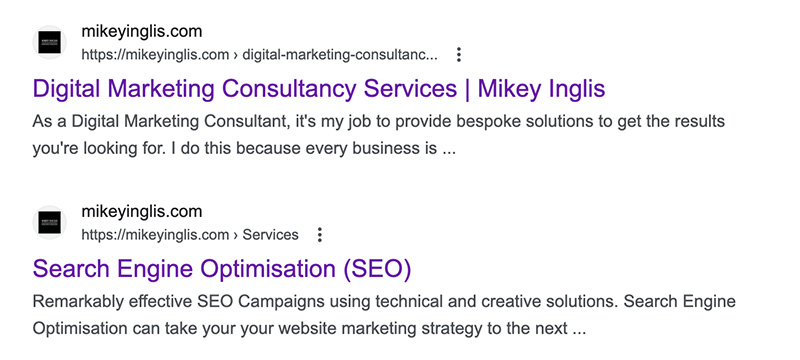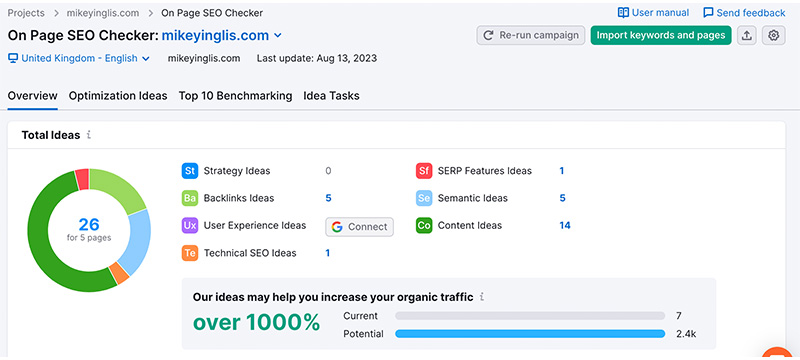Developing a winning Search Engine Optimisation (SEO) campaign can be challenging whether you’re a beginner or a tried-and-true SEO champion. Search engines, like Google and Bing, use complex algorithms to determine how websites are ranked and scored on search engine results pages (SERPs). While the exact details of these algorithms are closely guarded secrets, several well-known factors can play a significant role in determining your website’s SEO score.
What is an SEO Campaign?
Developing an SEO (Search Engine Optimisation) campaign is a coordinated and strategic effort to improve your website’s online visibility and ranking in SERPs. The primary goal of an SEO campaign is to rank for keywords your customers use to find your website, attracting organic (unpaid) traffic by optimising on-page elements that search engines look for when determining the relevance and quality of your site’s content. SEO campaigns involve a series of activities, usually including keyword research, content audits, web page optimisation, link building, and many other attributes aimed at improving a website’s overall SEO performance. Think of these activities as a giant checklist you need to run through to optimise your site for best performance.
An effective SEO campaign strategy can include:
- Competitor analysis
- Website health audit
- Keyword research
- Compelling content
- Optimise on-page SEO
- Quality backlinking
- Sharing content online
- Content updates and revisions
What are the Key Elements of an SEO Campaign?
A well-executed SEO campaign can launch your business into the spotlight. So where do you start?
1) Keyword Mastery: The SEO Journey Starts Here
Identify relevant keywords and phrases that your audience might use when searching for content related to your website. By undertaking keyword research, you’ll build a picture of keyword search volumes, what keywords your competition uses, and what a user’s intent is when they type their chosen keyword into a search engine.
Start by considering all the possible variations of search terms that might be relevant to your website, content, products, services and audiences. Tools such as Keyword Planner, SEMrush, and Moz can help you determine keywords and phrases by their search volume and how competitive they are to rank.

You may notice emerging keyword gaps that provide ample opportunity for you to rank. Or, if you opt for a competitive keyword, you should be prepared to make ‘skyscraper content’.
While conducting keyword research, it is important to understand ‘keyword intent’. Also known as search intent is a critical factor in SEO that refers to the underlying motivation behind your audiences’ search query. Understanding keyword intent is essential for creating and optimising content that aligns with what users seek, ultimately leading to higher search rankings and better user satisfaction.
There are generally four types of keyword intent:
- Informational Intent: When a user seeks information or answers to a question. They will typically use key phrases that start with “how to”, “what is”, and “benefits of” etc. Content targeting informational intent should provide valuable information to answer these queries.
- Navigational Intent: Users with navigational intent are trying to reach a specific website or page. They will often use keywords that include brands, websites, or location/local searches. Content optimised for navigational intent should include brand, contact information, or directions to a physical location.
- Commercial Intent: Users with commercial intent want to purchase or engage with a specific action. They might use keywords such as the product or service, “best price, “discount” etc.
- Transactional Intent: Similar to commercial intent but is more focused on completing an action beyond just making a purchase, such as signing up for a newsletter, downloading a resource, or requesting a quote. Keywords for this intent might include “download”, “subscribe”, or “get quote”.
It’s crucial to conduct thorough keyword research and analysis to effectively address keyword intent, paying attention to the language users use and the context of their queries.
I recommend referring to your to digital marketing strategy to help guide you with your keyword research and underpin which keyword intent best aligns with your strategy.
2) Content Excellence: Quality over Quantity
Search engines rank sites with rich content related to the search query. It’s important to consider your audience’s search queries and produce valuable, informative content that answers the users’ questions. Crawlers will scan your content and score it against other websites competing for the same key phrase. Your objective isn’t just about satisfying the metrics of search engines like Google and Bing; you will want your content to convert visitors into customers. Search engines’ primary goal is to produce information for humans, so above all else, your content will need to inform, engage, and inspire your audience.
This is where you should refer to your content marketing strategy and use a buyer’s persona, branding, and understanding your audience’s pain points to produce quality content.
3) On-page Optimisation: Optimal Ranking
With your content ready and published, it’s time for on-page optimisation. We’ve explored the importance of content marketing for SEO, but for optimal results, understanding how search engines crawl pages will enable you to optimise your page for search results.
This starts with optimising your meta title, meta description, headings, content structure, keyword usage, and image optimisation. It’s important to consider your keywords and search intent when drafting your meta title and description.

There are several free SEO plug-ins you can install on your content management system that allows you to submit your meta title and meta description for search engines to display in search results. One of the most popular plug-ins available is Yoast SEO. This will highlight your on-page SEO and provides hints and tips when you add your primary keyphrase to the focus keyphrase field.
You should apply your keywords to your content structure as you optimise your page. Make use of your primary keywords in your headline (H1) and break up your content into subheadings (H2 and H3) and use keywords in them too. The Yoast plug-in will count your key phrase density across the page content, and prompt you to add more of your keywords or take some out. The ratio between your keyword count and page word count needs to be balanced, so avoid keyword stuffing as this will result in poor SEO scoring.
Yoast SEO will also prompt you to use images on your website, and submit an alt-description. When you upload an image or video to your CMS, remember to fill in the alt-description field with your keywords. Not only will this provide your visitors with a strong visual aspect to your page, the alt-description will contribute to your SEO score by allowing search crawlers and visitors with impairments to understand the contents of the image/video.
Additionally, search engine crawlers will scan your site for links to other website pages. This is about measuring your page’s user experience and whether they can easily navigate around your website. When linking to alternative pages, it’s ideal to include descriptive text for crawlers and visitors to understand what the linked page relates to. Most SEO plug-ins will tell you to add inbound and outbound links to increase your SEO score.
Lastly, I recommend making use of the Yoast Schema tab. This provides search engine crawlers with page content details. You can use these to categorise web pages enabling crawlers to understand what they are. For example, service/product page, FAQs, about, contact etc.
Once you’ve optimised your webpage, submit your URL to Google Search Console’s URL Inspection. This will give you the option to ‘Test Live URL’. The URL inspection will provide details on whether the page is indexable, mobile usability and site links. Provided no issues are identified from the inspection, you should ‘Request Indexing’.

For deeper on-page optimisation, you should consider researching the competitor search landscape. Start by searching for keywords and phrases that you want to rank for. Look at your competitor’s content with the goal of creating pages that rank above theirs.
Earlier, I mentioned something called ‘skyscraper content’. This is where you review high ranking competitors for keywords you want to rank for. Take note of the word count and level of detail so you can use it as a benchmark. Now make your own content with a higher word count and demonstrate more depth of detail. This doesn’t mean copy their content so to speak, because your content needs to be original, but instead make it your own and take it further.
4) Quality Backlinks: The Pillars to Ranking Top
Backlinks are websites that link to your own site. Often referred to as referring domains, backlinks contribute to your website’s domain authority. Search engines consider your domain authority when ranking your site for search results. Securing backlinks from other websites can significantly boost your online visibility and search engine rankings. While you may have relied solely on your own efforts in the past, it’s time to take advantage of the power of external links. Fortunately, there are some effective strategies available to help you acquire the backlinks you need to achieve your goals:
- Perseverance is priceless: Keep doing what you’re doing. Writing quality content that demonstrates your expertise in your respective industry will get you noticed and in time, obtain quality backlinks.
- Ask nicely: Reaching out to websites with similar content to yours and politely asking them to mention you can go a long way. Make a strong pitch about why your content is relevant to theirs and explain how it can benefit their readers. Offer to write a short blurb for them containing your link. Create a spreadsheet, log all the emails you send and create a custom URL parameters to track traffic coming from these sites
- Marketing outreach: Consider approaching industry influencers, publishers, and brands to publish your content on their platforms. This not only provides quality backlinks to your website but opens your reach out to new audiences.
Obtaining quality backlinks can take time, which is partly why SEO is a long-term objective, especially if your website is brand new and starting with zero-domain authority. Countless websites claim to provide backlinks for a price, but these often turn out to be spammy and detrimental to your SEO scoring. I recommend staying clear of these and opting for ‘white hat’ backlinks. The solutions I mentioned above will help you obtain these super backlinks; however, I recently came across a blog from Backlinko that gave me a remarkable tip on getting white hat backlinks just from helping reporters with their articles.
It’s a free service called HARO – Help A Reporter Out. Simply sign-up as a contributor, and you will receive requests from reporters asking for information about a subject. You will need to be a subject matter expert, but if your contribution is published, then they will mention you in their article. Most often than not, these publications tend to hold high authority domains, which is a win for increasing your domain authority.
5) Core Web Vitals: User Experience Excellence
In 2021, Google rolled out the Core Web Vitals algorithm update, designed to give visitors a more enjoyable and secure page experience. Following this, Core Web Vitals became a new signal for search engines to rank websites. So, what does Core Web Vitals mean for your SEO campaign?
You must ensure that your site meets search engine user experience metrics. You can check your Core Web Vitals by using PageSpeed Insights. Just enter your URL, and you’ll be given a score across four categories:
- Performance: Measures your page loading speed and data consumption.
- Accessibility: Determines your content availability to users with impairments.
- Best Practice: Evaluates the compliance of your website with guidelines around safety, JavaScript, images, etc.
- SEO: Calculates basic on-page optimisation practices.

Your results will include recommendations to improve your score across these four categories. In most cases, PageSpeed Insights will recommend reducing unused CCS and JavaScript, reducing the size of images displayed on your webpage, eliminating render-blocking resources etc.
It’s worth noting, that from March 2024, Google will replace First Input Delay (FID) with Interaction to Next Paint (INP) as the Core Web Vital for Interactivity.
If you’re not well acquainted with the technical elements behind web development, speak to your web developer.
Your Core Web Vitals don’t need to be perfect since search rankings are compared against competing websites. Having a regulary and consistent plan to enhance your pages over time and reviewing your competitor’s Core Web Vitals and comparing their score to yours should be part of your long-term seo strategy.
6) Analyse Results: Actionable Insights
Measuring the results of SEO campaign involves a variety of metrics that reflect the impact on website visibility, traffic, and overall performance in search results. To measure your SEO campaign, you should review the following:
Organic Traffic: This is the most fundamental metric. It refers to the number of visitors who arrive at your website through organic (non-paid) search engine results. An effective SEO campaign should lead to an increase in organic traffic over time.
Keyword Rankings: Monitoring the rankings of targeted keywords is essential. Tools like Google Search Console or third-party SEO tools can help you track how well your website is ranking for specific keywords. Improvement in keyword rankings for relevant terms signifies that your SEO efforts are making an impact.
Click-Through Rate (CTR): CTR or ‘Views’ in GA4 measures the percentage of users who click on your website’s link after seeing it in the search results. This metric is how you measure organic traffic.
Conversion Rate: Ultimately, most websites aim to convert visitors into customers or leads. Tracking the conversion rate for specific landing pages or target keywords can help you understand how effectively your SEO campaign drives valuable actions for your visitors.
Average Engagement Time: Engagement measures how long visitors spend on your site after clicking through from search results. Longer engagement times suggest that visitors find your content valuable and engaging.
Backlinks: As we’ve previously covered backlinks, check how many quality backlinks refer to your site since your SEO campaign. Earning high-quality backlinks through your SEO efforts will positively impact your website visibility.
Domain Authority: With your new backlinks referring to your website, this will, in turn, increase your domain authority. Check the progress of your domain authority since launching your SEO campaign.
ROI: Ultimately, the success of an SEO campaign should be tied to its impact on the bottom line. Measuring the return on investment by calculating the revenue generated from organic search traffic compared to the cost of the campaign can provide a clear picture of its effectiveness.
It’s important to note that SEO results can take time to materialise, and not all metrics will show immediate improvements. You can measure the results of your SEO campaign by using tools and reports found in Google Analytics. This will help you determine those important page views, engagement, and conversions. But for measuring keywords, backlinks, and domain authority, you’ll get good insights from SEMrush. This tool will provide you with live data for your website, your competitors, and where you can improve to become more competitive.

So how long will it take to see results from an SEO campaign?
The time it takes to see results from SEO is around six to twelve months. By results I mean a measurable increase in traffic, leads and conversions. It’s impossible to give an exact timeframe that applies to all websites, so the best that can be offered is an estimate based on analysis of a website’s current performance and the proposed strategy. Much of it will depend on current backlinks and domain authority and getting together quality search engine optimised content.
Why does SEO matter?
SEO is a widely used tool for fostering business growth by enhancing online visibility and driving organic website traffic. A well-executed SEO campaign will help achieve this and subsequently increase your leads and sales. The first page of Google search results captures over 71% of search traffic clicks underscoring the importance of high rankings. Increased visibility directly translates to heightened brand exposure and recognition.
Additionally, SEO’s focus on relevant keywords and high-quality content aligns with user intent. 75% of users never scroll past the first page of search results. Essentially, this means that users are finding the answers to their search queries in the first page of search results. This highlights the necessity of SEO-driven strategies that resonate with user queries, ultimately driving targeted organic traffic.
Finally, Organic search is a cost-effective means of attracting website visitors, making SEO a valuable investment for businesses. 94% of search users ignore paid ads in favour of organic search results. By organically attracting potential customers, businesses reduce customer acquisition costs and build long-term trust and relationships.
Get expert help with your SEO Campaign
Getting to grips with the necessary components of SEO or even having the time can be a massive challenge for someone new to optimising a website, especially if it’s your first time. There’s a lot that needs to be considered and as you now know it’s a continuous effort.
Working with a search engine optimisation consultant (like me) is an affordable and sustainable choice for businesses looking to improve their rankings. To find out how I can support your business growth, take a look at my SEO packages, or contact me today for a free, no obligation quote.


